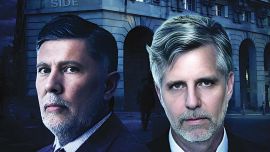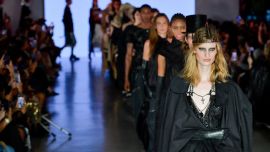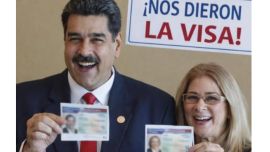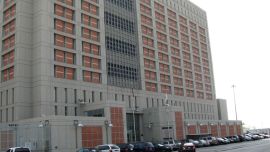Despite this advantage, this column will not attempt any mayoral race forecast, which is always going to be a hostage to fortune with almost four months still to go in a country like Argentina. In the last mayoral election in 2015 incumbent Mayor Horacio Rodríguez Larreta seemed headed for a walkover as the strongest card in what turned out to be a winning hand, given that this metropolis is both the birthplace and the core base of President Mauricio Macri’s PRO centre-right party, but he was forced into a run-off which he won by only 3.28 percent.
Undeterred by this close shave (which should not be understood as a reference to his bald pate) and by discouraging opinion polls for PRO at national level with weak performances across the provinces, Rodríguez Larreta is bidding for re-election with some confidence after four years of hyperactive hands-on administration and with Radical/Evolution deputy Martín Lousteau (his runoff rival of 2015) on his side as his leading senatorial candidate.
With Lousteau crossing over, Larreta’s main competition will presumably come from Matías Lammens, the president of San Lorenzo football club (the favourite team of Pope Francis). Frente de Todos has thus opted for an outsider even if the 2015 Peronist mayoral candidate Mariano Recalde was so confident of a repeat chance (despite not even making the runoff) that he has written a widely publicised book Gobernar la Ciudad about how he would run the city – Recalde must now settle for squaring off with Lousteau at senatorial level.
Roberto Lavagna’s son Marco tried to keep the Federal Consensus 2030 mayoral candidacy in the family but in the end it went to the popular economist Matías Tombolini while Marco Lavagna will seek to renew his Lower House seat. The FIT leftist challenger is Gabriel Solano. Five other lists are competing, all headed by unknown names – Frente Despertar (whose presidential candidate is t h e market fundamentalist José Luis Espert), Autodeterminación y Libertad (headed by the veteran libertarian leftist Luis Zamora, who prefers to run for a Congress seat he might actually win), the dissident New Movement to Socialism (whose leader Manuela Castañeira is the only female presidential candidate), the Christian Democrats (who appeal to the pro-life vote against abortion) and the neo-Nazi Patriotic Front.
Since national parliamentary voting is so intense in the Federal Capital this year with seats in both Houses of Congress at stake, we will move straight to that level and skip the City legislature. The three outgoing senators are Upper House Provisional President Federico Pinedo and Marta Varela (both PRO) and Fernando “Pino” Solanas representing the anti-Kirchnerite progressive UNEN with Elisa Carrió back in 2013 and ousting the Victory Front senator Daniel Filmus – none of this trio is seeking reelection. It remains to be seen whether Pinedo is a future Cabinet minister should Macri win. Solanas has joined Frente de Todos as its leading Lower House candidate. Varela was an almost invisible senator and any chances of her staying in the Upper House would be crushed by her vote against last year’s abortion bill, which would veto her in Lousteau’s eyes. Instead Lousteau will be accompanied by the more pro-choice Guadalupe Tagliaferri and they are highly likely to be the next senators along with Recalde. With the exception of the Patriotic Front, the seven lists running for mayor have also named senatorial candidates but all are unknown.
The table shows the current 25 Federal Capital deputies with 12 of these seats to be renewed in October.
Only five of the 12 deputies ending their terms this year will be seeking to retain their seats with only PRO’s Pablo Tonelli and Alvaro González staying in the same party – Sergio Massa’s UNA has disintegrated into Marco Lavagna staying with his father while Carla Pitiot has joined Frente de Todos, as has Victoria Donda. Both gubernatorial candidate Axel Kicillof and La Cámpora’s Andrés “Cuervo” Larroque have emigrated to Buenos Aires province.
The lists of both the main fronts have a hybrid look in line with the recent expansion of their alliances. Not much PRO yellow in the upper slots of Rodríguez Larreta’s list with Maximiliano Ferraro and Mariana Zuvic responding to Carrió’s Civic Coalition and pro-Lousteau Radical Emiliano Yacobiti occupying three of the first four places although the militantly pro-life Victoria Morales Gorleri is second. Paula Penacca and Eduardo Valdés are the only real Kirchnerites in the top half of the Frente de Todos slate with the massive immigration from elsewhere – not only Solanas, Donda and Pitiot but also the leftist Itai Hagman. By casting such a wide net, the two main coalitions should virtually hog the field (with the opposition perhaps picking up a seat) with Marco Lavagna, Zamora and FIT’s Myriam Bregman perhaps the only candidates from third parties with any chance of entering the Lower House.
Before moving to the historical and geographical sections of this column, it might be worth asking why the Federal Capital is privileged with 25 seats as against 19 for Santa Fe and 18 for Córdoba when the latter has around a quarter million more voters than this metropolis and about 100,000 more than Santa Fe.
This city dates back to its two foundations in 1542 and 1580 but it has less than a quarter-century of electoral history. There was not even an appointed mayor until Torcuato de Alvear (1883-7), father of the later Radical president Marcelo T.– three years after the creation of a federal district in 1880. De Alvear was followed by 65 more presidential appointees through to Peronist Jorge Domínguez (1994-6), all faithfully following the national government of the day, whether conservative, Radical, Peronist or military. The list includes some familiar surnames from current politics such as Pinedo, Bullrich and Suárez Lastra. Some were more notorious than others – thus the military dictatorship’s Osvaldo Cacciatore (1976-82) and Domínguez made free with the bulldozer – but all were basically presidential lackeys.
Since 1996 there have been six elections and six mayors although not as linear as this might seem. Two of the mayors (Aníbal Ibarra and Macri) gained re-election while two were caretakers – the late Enrique Olivera (1999-2000), whose eight months included the millennium celebrations, and Jorge Telerman (2005-7).
The first election in mid-1996 was a major stepping-stone towards Radical Fernando de la Rúa’s ill-starred 1999-2001 presidency, a promotion which brought in Olivera. There was no runoff for De la Rúa, who became mayor with just under 40 percent. But no mayoral candidate has won an absolute majority in any election since it was made mandatory in 1997 although the runoff was waived in 2000 when Ibarra came within 0.7 percent against the Domingo Cavallo-Gustavo Beliz ticket. It was a different story when Ibarra ran for re-election against 27 rivals in 2003 – he even lost the first round with only a third of the vote as against 37.5 percent for the brand-new PRO Macri-Rodríguez Larreta ticket but then drew two-thirds of the alternative votes in the runoff to win by seven points. But the Cromañón rock club blaze in late 2004 claiming 193 lives was to end Ibarra’s mayoral career 15 months later – perhaps unfair in itself since tragedies can happen under any government but also the tip of the iceberg for a slipshod administration favouring politics over municipal management.
The Telerman interim was then followed by the continuing reign of the far more managerial PRO, winning three straight elections since 2007 in convincing fashion. Macri (accompanied by current Vice-President Gabriela Michetti in 2007 and Buenos Aires Province Governor María Eugenia Vidal in 2011) won both elections against Filmus with upward of 45 percent in the first round and upward of 60 percent in the second. In 2015 Macri moved house to Olivos presidential residence like De la Rúa before him and was succeeded by Rodríguez Larreta with that 3.28 percent runoff win mentioned at the start of this column.
One good way of measuring PRO dominance during this period would be the 15 communes created shortly beforehand in 2005. PRO has coloured every single one of those yellow in all the first rounds since 2007 but lost nine of the 15 to Lousteau in the 2015 runoff. A closer look at communal results would tell us much about this city’s political geography.
Three communes have always given PRO an absolute majority – 2 (Recoleta), 13 (Belgrano) and 14 (Palermo), all opulent northern neighbourhoods lining the estuary. This trio plus Communes 1 (downtown between Retiro and Constitución stations, including San Telmo and Puerto Madero), 4 (Boca and Barracas) and 12 (Villa Urquiza and Saavedra) form the sextet won by PRO in every election. At the other end of the scale Commune 8 (including the Peronist stronghold of Villa Lugano, Villa Soldati and Riachuelo in the extreme south) is usually seen as the most resistant to Macri as a rougher, low-income neighbourhood but Communes 5 (Almagro) and 15 (Chacarita) have also given PRO percentages below 40.
This leaves us with half a dozen communes clustered on either side of the central Avenida Rivadavia artery – the porteño heartland – where PRO has always won the first round with below average marks. These are 3 (Balvanera and San Cristóbal), the lower middle-class communes 6 (Caballito) and 7 (Flores), 9 (Liniers and Mataderos, the traditional meatpacking zone), 10 (Floresta) and 11 (residential Villa Devoto, perhaps the most proPRO of this grouping). As it happens, many of these communes gave the centre-left Ibarra his best votes in the first years of this century.
No tourist tips today for at least two reasons – lack of space but
also because Buenos Aires does not offer so much to the sightseer
(is the Obelisk really all that fascinating?) as to the more permanent resident with all the cultural wealth and pleasant lifestyles
of a world city.related news





















Comments